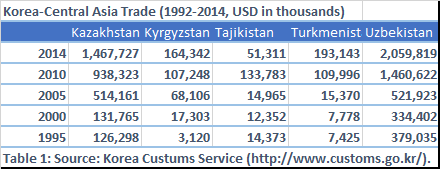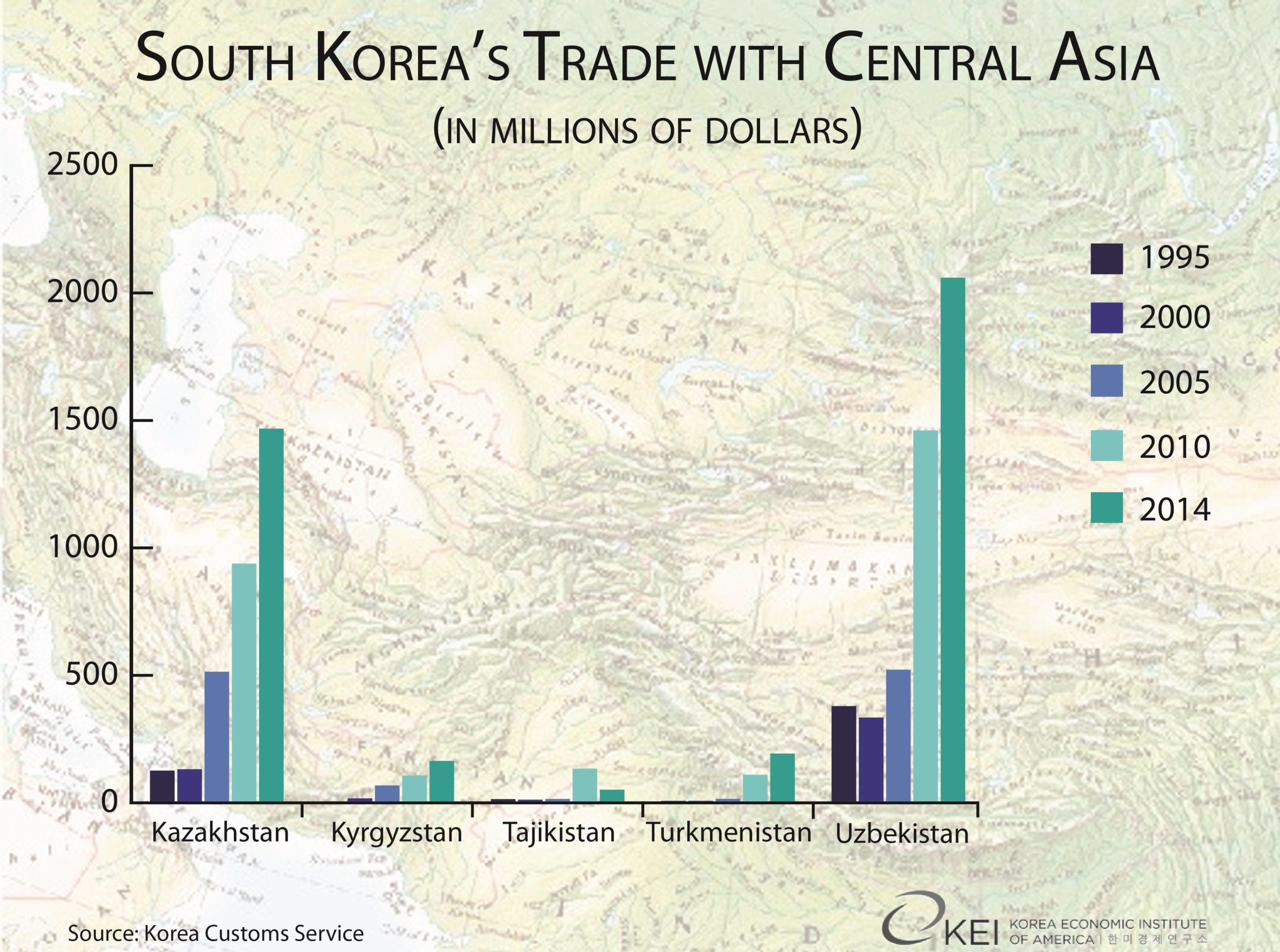The Peninsula
South Korea Seeks Opportunities in the New World of Central Asia
Published June 16, 2016
Category: South Korea, Current Events

By Jiwon Nam
Central Asia is a region that borders China and Russia to the Northeast and the Middle East to the West. The region generally consists of five countries: Kazakhstan, Kyrgyzstan, Tajikistan, Turkmenistan, and Uzbekistan. Although Central Asia is not a major economic and diplomatic partner for South Korea, the countries of Central Asia have the potential to grow in the future as economic and trade partners for South Korea. This blog examines the brief history of Central Asia and how these five countries were developed as individual countries after the disintegration of the Soviet Union. Then the paper explains the past and current relationships between Central Asian countries, and South Korea to determine potential opportunities for South Korean investment.
The countries of Central Asia abruptly became separate countries after the disintegration of the Soviet Union in 1991. Regional instability and socio political issues arose from the birth of Central Asian countries and it has continued into the current day. An example of the socio political issues is ethnic and religious tension in Tajikistan. The Tajik Civil War started in 1992 and lasted for 5 years until 1997. The Tajik Civil War was caused by religious and ethnic tension between a democratic Islamic group and a socialist one that was receiving support from the Russian government. This civil war caused between 20,000 and 50,000 deaths. Even though the war ended with a peace treaty, suppression of democratic Islamists in the country continues to this day creating tensions in the country. Not only is Tajikistan experiencing instability, but the other Central Asian countries are also. Statistics from Fragile State Index indicate that two of the five Central Asian countries, Uzbekistan, and Tajikistan, are categorized at the “High Warning” stage, and Kyrgyzstan and Turkmenistan are categorized at the “Warning” stage, while Kazakhstan is in the “Low Warning” stage. Despite the region’s current unstable status, Korea has a strong historic and ethnic ties with Central Asia and the region is beneficial enough to alleviate Korean economy.
The relationship between South Korea and Central Asian countries began in early 1800s, especially through forced migration. Koreans who lived in certain regions of Russia that border Korea started to be involuntarily moved from 1860s until the largest forced deportation in 1937. After losing Russo-Japanese War, Joseph Stalin began a policy of deporting Koreans to the far west. Having considered that it was only a matter of time before Korea was placed under the control of Japan, Stalin did not want to have any potential danger of having Koreans who may collaborate with Japan in Soviet Union territory. Under Stalin’s rule, Koreans who were living in Vladivostok and the Khabarovsk region, as well as Kraskino and the Posyet region were forced to move to the unpopulated regions of the Soviet Union which is current day Central Asia. Almost 100,000 people were shipped only to Tashkent, Uzbekistan, and total of around 200,000 people were deported in 1937. Descendants of the Korean migrants still live in Central Asia; the relationship between South Korea and the Central Asia continues until present day.
In the past two decades, trade between South Korea and Central Asia has been increasing as the data in Table 1 and Figure 1 indicate. Especially as South Korea has put up an effort to increase the economic relationship with Central Asian countries. An example is the creation of the Comprehensive Central Asia Initiative which was established in December 2005 under President Roh, Moo-hyun. Furthermore, in 2009, the new Asia Initiative was launched resulting in a 30% increase in trade with Uzbekistan and 50% increase with Kazakhstan within a year. As Fumagalli depicts in his article, between 1992 and 2014 trade between Korea and Central Asia increased dramatically.
Figure 1. Increase in Trade between South Korea and Central Asia
As we can see in the charts above, trade between Central Asian countries and South Korea has been increasing for the last two decades. Especially with Kazakhstan and Uzbekistan, trade increased dramatically in the late 2000s. Central Asia has large deposits of natural gas and oil. It is particularly beneficial for South Korea to expand its relationship with Central Asia in light of the region’s vast amount of natural resources, something which South Korea lacks. Another benefit of having Central Asia as a trading partner is the potential to lessen South Korea’s reliance on the Middle East for oil and natural gas. South Korea imported 34% of its oil from Saudi Arabia, 16% from Kuwait and 11% from United Arab Emirates as of 2014. South Korea imports 97% of its natural resources and oil and the majority of the oil is from the Middle East. Instead of competing with many other countries that import oil from the Middle East, it is more secure and beneficial for South Korea to find a different source; Central Asia can be the one.
In conclusion, South Korea had sparsely been in contact with Central Asian countries since the mass deportation in 1937. Ties among these countries were rebuilt in the late 1990’s. Especially after the Asian financial crisis, trade between South Korea and Central Asian countries has been increasing substantially. With the launch of the new Asia Initiative in 2009, trade between South Korea and the Central Asian countries has increased significantly. Furthermore, South Korea has geopolitical comparative advantages and cultural ties with Central Asian countries. Using the advantages that South Korea has can be beneficial to the country’s own growth as well as giving Central Asian countries opportunities for economic development.
Jiwon Nam is currently an intern at the Korea Economic Institute of America and a graduate student at the University of Maine. The views expressed here are the author’s alone.
Photo from Mariusz Kluzniak’s photostream on flickr Creative Commons.

